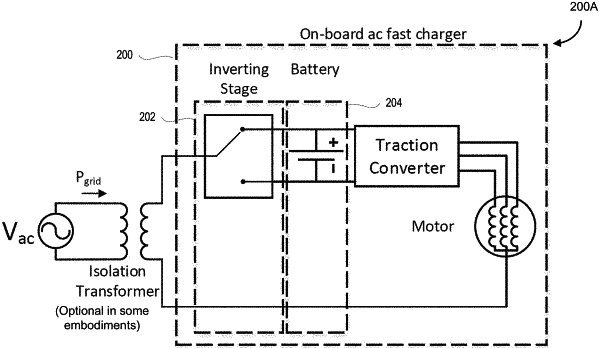| CPC H02J 3/322 (2020.01) [B60L 53/122 (2019.02); B60L 58/12 (2019.02); H02J 50/10 (2016.02)] | 20 Claims |

|
1. An electric vehicle fast charger adapted for using magnetic components of one or more motors of an electric vehicle having one or more traction converters having one or more traction converter switches when the electric vehicle is stationary, the electric vehicle fast charger comprising:
differential terminals configured for coupling to a power grid providing a grid voltage, the differential terminals carrying a grid current between the power grid and the electric vehicle fast charger;
one or more sensors coupled to the power grid to track a waveshape and a frequency of the grid voltage being provided by the power grid;
one or more sets of switches of a first switching stage residing on-board the electric vehicle coupled to the power grid through the differential terminals and coupled to a corresponding energy storage device of one or more energy storage devices, each set of switches including at least one of: current uni-directional switches or current bi-directional two quadrant switches;
the one or more energy storage devices, each coupled to a corresponding set of switches of the one or more sets of switches and coupled to a corresponding traction converter of the one or more traction converters; and
a switching controller configured for generating gating signals for:
controlling the switches of the one or more sets of switches of the first switching stage to (i) operate at the frequency of the grid voltage to conduct inversion of the grid current at the frequency of the grid voltage, or (ii) operate at a frequency higher than the frequency of the grid voltage to conduct current shaping of the grid current to adapt the grid current to approximate the waveshape of the grid voltage; and
controlling the one or more traction converter switches to (i) operate at the frequency of the grid voltage to conduct inversion of the grid current at the frequency of the grid voltage, or (ii) operate at a higher frequency than the frequency of the grid voltage to conduct current shaping to rectify the grid current to approximate the waveshape of the grid voltage;
wherein at least one of the switches of the one or more set of switches of the first switching stages and the one or more traction converter switches provides inversion and at least one of the switches of the one or more set of switches of the first switching stages and the one or more traction converter switches provides current shaping by using leakage inductance of the one or more motors of the electric vehicle when the electric vehicle is stationary.
|